
Stir-fried Pork Slices with Pleurotus ostreatus is a homely dish that can make people recall the taste for a long time! The meat is fresh and tender, and the Pleurotus ostreatus is refreshing. When they are paired together, it is simply a feast for the senses. When stir-fried with hot oil, the pork slices change color instantly and the Pleurotus ostreatus follows suit, as if they are dancing a cheerful dance. The addition of seasonings makes the dish even more fragrant, which stimulates one’s appetite. Taking a bite, the deliciousness of the pork slices and the sleekness of the Pleurotus ostreatus are perfectly combined, giving a rich texture and making people unable to resist taking bite after bite.
Ingredients for Stir-fried Pork Slices with Pleurotus ostreatus:
| Pork | 200g |
| Pleurotus ostreatus | 200g |
| Green pepper | 10g |
| Red pepper | 10g |
| Green onion | 10g |
| Ginger | 5g |
| Salt | 2g |
| Chicken powder | 1g |
| Dark soy sauce | 2g |
| Light soy sauce | 2g |
| Egg white | 20g |
| Sugar | 1g |
| Essence of chicken | 1g |
| Oyster sauce | 5g |
| Edible oil | 6g |
| Dried chilli | 5g |
| Corn starch | 15g |
Step:
1.First of all, let’s start preparing the ingredients. Choose 200 grams of fresh pork and cut it into even thin slices. Such thin slices can better absorb the flavors of the seasonings during the cooking process and have a more tender texture. Then place the sliced pork in a bowl and pour in an appropriate amount of water to soak. The purpose of doing this is to remove the blood and impurities in the pork, making the fried pork slices cleaner and more delicious. The soaking time does not need to be too long, about 5 minutes will do.
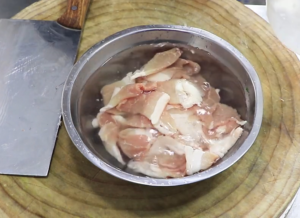
2.Before starting to cook, rinse 200 grams of Pleurotus ostreatus, then cut off the root. Next, tear the Pleurotus ostreatus into even strips and place them in a bowl for later use. The purpose of this step is to make the Pleurotus ostreatus more susceptible to absorb flavors during the cooking process and have a more delicious texture. Then, select a red pepper and a half green pepper and cut them into diamond-shaped pieces respectively. The bright colors of the red and green peppers can add a touch of color contrast to this dish and make the finished product look more attractive. Place the sliced green and red pepper pieces and the Pleurotus ostreatus in the same bowl for later use.
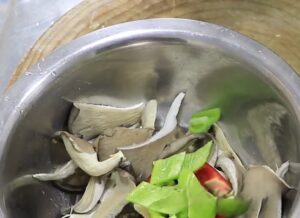
3.Let’s prepare the ingredients for the seasoning. First, take out a large shallot and cut it into water chestnut-shaped slices. Water chestnut-shaped slices are a special cutting technique where the shallot is cut into thin slices with a shape similar to that of a water chestnut. Doing so allows the shallot to better bring out its unique aroma during the cooking process. Next, take out a piece of ginger and cut it into diamond-shaped pieces. Diamond-shaped pieces are a common cutting technique that allows the ginger to better absorb flavors during the cooking process and also adds more color to the dish. Place the sliced shallots and ginger in a bowl for later use. These ingredients will add a unique aroma and texture to the dish during the cooking process.
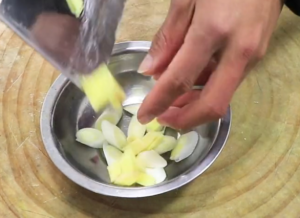
4.Now let’s wash the sliced pork. Gently press the sliced pork with your hand to help remove any remaining blood and impurities. By cleaning it carefully, we can ensure that the sliced pork is completely clean, which improves the overall eating texture. After washing, we will remove the sliced pork and place it in a colander. The design of the colander allows the water to drain out quickly, preventing the sliced pork from absorbing too much water. We will place our hand on the colander and gently press to help further drain the water out of the sliced pork. This step is very important because excessive moisture may make the fried pork slices too moist, affecting the texture. Next, we will place the pressed sliced pork in a bowl for later use.
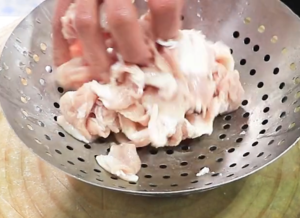
5.Next, we will marinate the sliced pork. Add 1 gram of salt, 1 gram of chicken powder, 2 grams of dark soy sauce, which can enhance the base color, and 2 grams of light soy sauce, which can remove the enhance the freshness. Mix well with your hands to dissolve the seasonings. Then, we will coat the sliced pork with starch. Add 1 egg white to the sliced pork and beat and mix well. Using egg white to starch the sliced pork prevents it from being separated and makes it smoother and more tender. Add 1 tablespoon of corn starch and mix and beat in one direction. Then add 1 tablespoon of cooking oil. The cooking oil can form a layer of oil film on the surface of the sliced pork, preventing it from sweating out and fully mix well. Let it marinate for 10 minutes to allow the sliced pork to fully absorb the flavors.
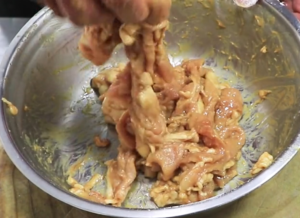
6.Pleurotus ostreatus is a nutritious ingredient, but it tends to sweat out during stir-frying, affecting the texture and quality of the dish. Therefore, we take a blanching method to effectively prevent the mushrooms from sweating out too much during stir-frying. To complete this step, we start by heating water in a pot. When the water boils, we will add the Pleurotus ostreatus and green and red peppers. Doing so allows the mushrooms and peppers to quickly cook under high heat while maintaining their nutritional content and bright colors. After 1 minute, we will use a strainer to remove the mushrooms and peppers and drain the excess water before setting them aside in a bowl for later use. This step is very important because blanched mushrooms and peppers not only remove excess moisture, but also make them more receptive to the flavors of the seasonings during stir-frying, resulting in a more delicious texture. By handling the mushrooms and peppers in this manner, we are able to better control the cooking temperature and seasonings when stir-frying Sliced Pork with Shiitake Mushrooms, allowing each ingredient to fully bring out its flavor.
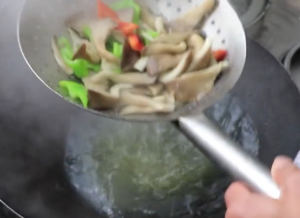
7.After we have all the ingredients prepared, we proceed with the meat-slicing and stir-frying step. This step is to make the meat slices tender during the cooking process and prevent them from over-stir-frying at high temperatures, maintaining their original taste and texture. We start by heating the oil in a pot until it reaches a temperature of 140°C. This temperature is the best for stir-frying meat slices, ensuring that they slide into the oil quickly without burning. When the oil temperature reaches 140°C, we quickly add the meat slices into the pot. If the meat slices stick together during the stir-frying process, we use a spoon to gently separate them. This action should be quick and gentle to avoid damaging the meat slices’ integrity and texture. Stir-frying the meat slices is a crucial step because it makes them tender and enhances their flavor. We should not stir-fry them for more than one minute. This time frame ensures that they do not over-stir-fry while fully absorbing the aroma of the oil. When the meat slices turn slightly pale, we quickly remove them from the pot and let them drain excess oil. This step prevents the meat slices from over-stir-frying and becoming dry, which would affect their texture and taste. The drained meat slices are now more tender and flavorful, ready for the next step of cooking.
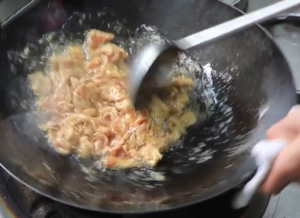
8.After completing the meat-slicing and stir-frying process, we proceed to the next cooking step. We leave a small amount of the base oil in the pot and heat it up before adding the sliced green onions and ginger. The aroma of the green onions and ginger is quickly dispersed under the heat, adding a strong fragrance to the dish. We continue to stir-fry the green onions and ginger until they turn slightly golden, which will allow their aroma to penetrate deeper into our hearts. Then, we add a few dried peppers and fry them to bring out their aroma. It should be noted that the oil temperature should not be too high to avoid burning the dried peppers. We use medium-low heat to slowly fry the dried peppers, allowing their aroma to gradually emit. Next, we add the fried meat slices and blanched Pleurotus ostreatus into the pot. The meat slices, which have been stir-fried, are now tender and delicious, while the Pleurotus ostreatus is more crisp after blanching. We quickly stir-fry the meat slices and Pleurotus ostreatus for 15 seconds, allowing them to fully absorb the flavor of the seasonings. Now, we move on to the final seasoning step. We add 1g of salt, a little bit of chicken essence, and 1g of sugar. The amount of sugar should not be too much, mainly to enhance the taste and make the dish more delicious. Then, we add 5g of oyster sauce. The oyster sauce not only enhances the flavor but also adds richness to the dish. Finally, we use high heat to quickly stir-fry the meat slices and Pleurotus ostreatus, allowing the seasonings to dissolve and distribute evenly in the dish. When the seasonings are completely dissolved, we quickly remove the pot from the heat and plate the dish. A delicious dish of Pleurotus ostreatus fried with pork is now complete!
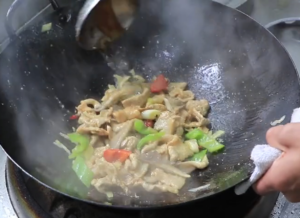
Tips:
1. It is best to marinate the meat slices before stir-frying, so that it can add more flavor and taste better.
2. Keep a good grasp of the heat when stir-frying, so as not to stir-fry or not cooked.

